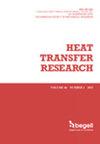A step forward on the network method for radiation heat transfer analysis in enclosures
IF 1.6
4区 工程技术
Q3 THERMODYNAMICS
引用次数: 0
Abstract
It is proposed an approach of the network method for radiation in enclosures that expresses radiosities and irradiations as functions of the blackbody emissive powers and of the radiation fluxes entering the enclosure through its partially transparent walls. These results are used to express the radiation heat flow exchanged between two surfaces and the net radiation heat flux leaving each of the enclosure’s surfaces as depending on these true driving forces for radiation heat transfer. This reduces the problem to its essential, as these are the true driving forces for the radiation heat transfer. Net radiation heat fluxes leaving each of the enclosure’s surfaces form an equations’ system from which are evaluated the relevant radiation heat transfer parameters for each surface. Proposed approach is based on elementary matrices operations, the main attention being dedicated to the problem setting and leaving the (just essential) calculations to the calculator or to the computer. It is introduced for enclosures with all opaque walls and illustrated for one example, and then extended to enclosures with partially transparent walls. Proposed simplifying and unifying approach is relevant not only for radiation heat transfer analysis and calculations, but also for pedagogical purposes, retaining attention on the essential of the radiation heat transfer problem formulation, setting aside intermediate/auxiliary variables calculations that are usually aversive, fastidious, distractive and prone to errors.围护结构辐射传热分析网络法向前迈进了一步
该方法将辐射量和辐照量表示为黑体发射功率和通过部分透明墙壁进入外壳的辐射通量的函数。这些结果用于表示两个表面之间交换的辐射热流和离开外壳每个表面的净辐射热通量,这些都取决于辐射传热的真正驱动力。这就从根本上解决了问题,因为这些才是辐射传热的真正驱动力。离开围护结构各表面的净辐射热通量构成了一个方程系统,从中可以评估各表面的相关辐射传热参数。建议的方法以基本矩阵运算为基础,主要关注问题的设置,将(必要的)计算留给计算器或计算机。该方法适用于所有不透明墙壁的围护结构,并以一个例子进行说明,然后扩展到部分透明墙壁的围护结构。所提出的简化和统一方法不仅适用于辐射传热分析和计算,也适用于教学目的,将注意力集中在辐射传热问题的基本表述上,而将通常令人反感、繁琐、分散注意力和容易出错的中间/辅助变量计算搁置一边。
本文章由计算机程序翻译,如有差异,请以英文原文为准。
求助全文
约1分钟内获得全文
求助全文
来源期刊

Heat Transfer Research
工程技术-热力学
CiteScore
3.10
自引率
23.50%
发文量
102
审稿时长
13.2 months
期刊介绍:
Heat Transfer Research (ISSN1064-2285) presents archived theoretical, applied, and experimental papers selected globally. Selected papers from technical conference proceedings and academic laboratory reports are also published. Papers are selected and reviewed by a group of expert associate editors, guided by a distinguished advisory board, and represent the best of current work in the field. Heat Transfer Research is published under an exclusive license to Begell House, Inc., in full compliance with the International Copyright Convention. Subjects covered in Heat Transfer Research encompass the entire field of heat transfer and relevant areas of fluid dynamics, including conduction, convection and radiation, phase change phenomena including boiling and solidification, heat exchanger design and testing, heat transfer in nuclear reactors, mass transfer, geothermal heat recovery, multi-scale heat transfer, heat and mass transfer in alternative energy systems, and thermophysical properties of materials.
 求助内容:
求助内容: 应助结果提醒方式:
应助结果提醒方式:


